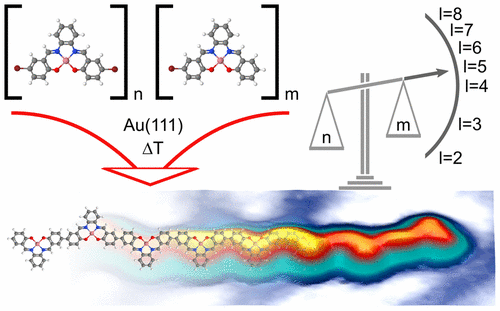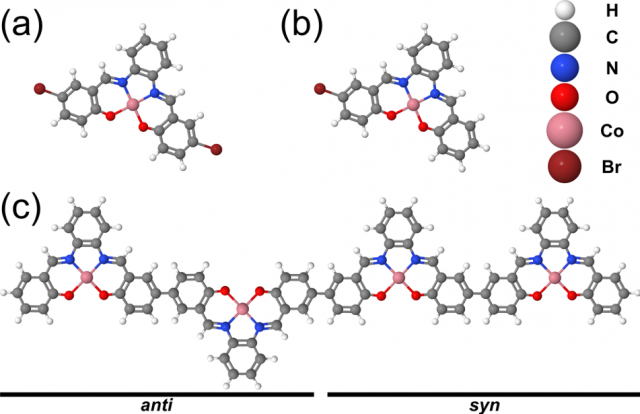Towards a bottom-up engineering of molecular spintronic devices

During the last decades, the electronics industry has been very successful in pushing forward the advancement of electronic building blocks, but the limit of silicon-based electronic devices especially in terms of miniaturization are almost reached. There are many ideas how to overcome this problem, for example, by adding functionality based on approaches originating from molecular electronics, quantum electronics, or atomic scale spintronics.
In spintronics, new memory and logic devices are being developed based on the use of spins of nuclei, atoms, or molecules, instead of electronic charges. The main advantages are an improved energy efficiency and speed of operation to store and process information.
It is possible to build a spintronic nanoscale device, based on single magnetic atoms artificially arranged on a surface by single-atom manipulation. However, the drawbacks of this type of atomic-scale spintronics for any industrial application are obvious: ultralow operating temperatures and the tediousness of assembling each individual atom of the device are just two of them.
The ideal spintronic device should be thermally stable, self-assembled, and make use of a strong magnetic coupling between the individual building blocks. All of these features can potentially be achieved by employing covalently bonded molecules. Actually, the tip of a scanning tunneling microscope (STM) can be used to couple individual molecules on a surface, but, again, this is not efficient on the industrial scale for a large number of molecules.
Chemistry may be of some help, though. Molecular chains which can transfer spin information has been reported in 2012 by DiLullo et al. They prepared these chains on surfaces containing multiple paramagnetic metal ions separated by ligands that mediate an intermolecular magnetic coupling between the metal ion spin centers. However, the longest oligomers studied consisted only of five monomers, and it is not clear whether more extended chains can be oligomerized in a controlled way.
On the other hand, it is known that one- and two-dimensional supramolecular nanostructures can successfully be synthesized on a variety of substrates by utilizing different on-surface chemical reactions. Why not trying to achieve specific on-surface linking of spin-carrying molecules? This would lead to a whole new area of molecular spintronics. The proof of principle for this approach was provided by Bazarnik et al in 2016.
Now a team of researchers, including Mikel Abadia and Jens Brede, from CFM and DIPC, present 1 a method to control the length of molecular spintronic chains and to make their terminations chemically inert, thereby suppressing uncontrolled coupling to surface defects.

The researchers used a heterogeneously catalyzed reaction in which two aryl halides are coupled to form a biaryl in the presence of a coinage metal. The two different molecular precursors to control oligomerization and oligomer length are 5,5′-dibromosalophenatocobalt(II) (Figure 1a), used as a chainlink due to its two reactive sides, and the asymmetrically substituted 5-bromosalophenatocobalt(II) (Figure 1b), introduced as a chain terminator.
A reaction of both types of molecules renders the chain end inert and thus stops further chain growth.Therefore, the average chain length can be steered by adjusting the ratio of both types of chain units. A model of a tetramer (i.e., a four-node chain) terminated on both sides is shown in Figure 1c. Individual monomers can react with the top benzene rings pointing either in the same direction (syn conformation) or in opposite directions (anti conformation), as marked in Figure 1c. Importantly, the bond between two monomers is essentially the same for both conformations, and therefore, the magnetic coupling within the oligomer is unaffected.
Using this method the team could steer the chain length from 3 (3.6 nm) to 10 monomers (11 nm). For relatively short oligomers up to six monomers (6.8 nm), the oligomerization yield is high. Actually, spin chains with as much as 76 monomers (81 nm) could be synthesized under appropriate conditions, but the reaction yield for such long chains is expected to drop dramatically.
This is another important step toward the final goal of a bottom-up engineering of molecular spintronic devices. Combining molecular electronics with spintronics creates new exciting possibilities in view of the coupling strength between and thermal stability of the individual building units as well as a parallel fabrication based on self-assembly.
Author: César Tomé López is a science writer and the editor of Mapping Ignorance.
References
- Emil Sierda, Mikel Abadia, Jens Brede, Micha Elsebach, Bernhard Bugenhagen, Marc Heinrich Prosenc, Maciej Bazarnik, and Roland Wiesendanger (2017) On-Surface Oligomerization of Self-Terminating Molecular Chains for the Design of Spintronic Devices ACS Nano doi: 10.1021/acsnano.7b04194 ↩